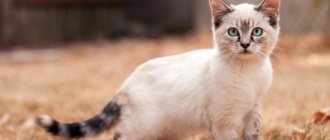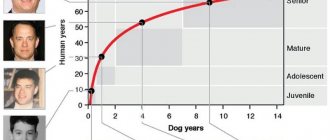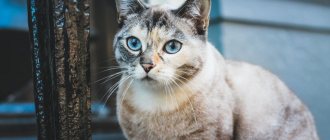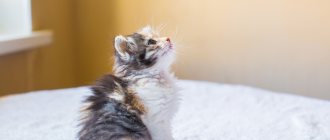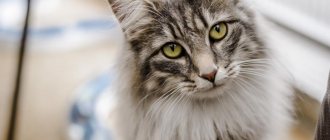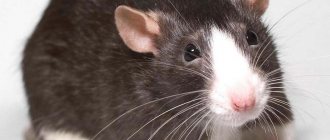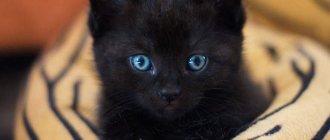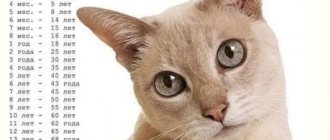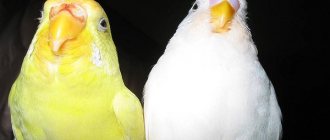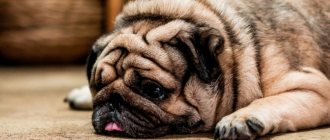- September 11, 2019
- Cats
- Vlasova Anna
Unfortunately, our purring pets are not given as much time as we would like. Many cat owners are curious about how old their pet would be by human standards. At what age is a kitten still considered a baby, and when does it “retire”? We bring to your attention several systems for calculating the ratio of cat age to human age. You will also learn about the developmental features at each stage of a cat's life.
Three calculation options
Many have wondered whether it is possible to represent the age of a cat in human years. Indeed, it is interesting and even funny. After all, wrinkles do not give away the age of purring fluffies. Wisdom or erudition also do not always depend on the date of birth of the pet. People have repeatedly tried to draw an analogy between the ages of people and cats, but they never came to a unified scientific theory. What calculation options are there?
One of the most popular theories is called "1:7". Multiply the cat's age by 7 and find out how old she would be if she was born a human. This is the simplest calculation option. For example, if a cat is 7 years old, by human standards she is already 49. For us, this is middle age. It is fraught with many hormonal changes. But with animals everything is different. For clarity, we put the calculation results in a table:
Age of a cat by human standards 1
| Cat (years old) | Person (years) |
| 1 | 7 |
| 2 | 14 |
| 3 | 21 |
| 4 | 28 |
| 5 | 35 |
| 6 | 42 |
| 7 | 49 |
| 8 | 56 |
| 9 | 63 |
| 10 | 70 |
| 11 | 77 |
| 12 | 84 |
| 13 | 91 |
| 14 | 98 |
| 15 | 105 |
Adherents of the second theory of determining the age of a cat in human years equate a one-year-old animal with a 15-year-old boy. This is a little closer to the truth, since at one year old cats are already capable of producing their own children. According to this theory, 2 years of a cat is comparable to 24 years of a person. From 3 to 12 years, one cat year is equal to 4 human years.
After 13 years, each year of a cat’s life by human standards must be multiplied by 3 and added to the previous figure. There is a more complex scheme for determining the age of an animal. To make it easier to understand, we put the calculations in a second table:
Age of a cat by human standards (second counting system)
| Cat (years old) | Person (years) |
| 1 | 15 |
| 2 | 24 |
| 3 | 28 |
| 4 | 32 |
| 5 | 36 |
| 6 | 40 |
| 7 | 44 |
| 8 | 48 |
| 9 | 52 |
| 10 | 56 |
| 11 | 60 |
| 12 | 64 |
| 13 | 67 |
| 14 | 70 |
| 15 | 73 |
| 16 | 76 |
| 17 | 79 |
| 18 | 82 |
| 19 | 85 |
| 20 | 88 |
Adherents of the third theory of calculation claim that the ratio of the age of a cat to a human is 1:7, but only in the first 5 years. From 6 to 12 years old, you need to multiply each year of the cat’s life by 4 and add to the previous value, and after 12 years, multiply by 3. If the cat is 12 years old, then the person is 63, and if 13, then 66. This and the previous theories have similar principles comparisons between the ages of cats and humans, especially in the second half of life. However, the period of growing up is assessed differently. We also put the calculation indicators for the third theory in the table:
The age of a cat by human standards (third calculation option)
| Cat (years old) | Person (years) |
| 1 | 7 |
| 2 | 14 |
| 3 | 21 |
| 4 | 28 |
| 5 | 35 |
| 6 | 39 |
| 7 | 43 |
| 8 | 47 |
| 9 | 51 |
| 10 | 55 |
| 11 | 59 |
| 12 | 63 |
| 13 | 66 |
| 14 | 69 |
| 15 | 72 |
| 16 | 75 |
| 17 | 78 |
| 18 | 81 |
| 19 | 84 |
| 20 | 87 |
How long do domestic cats live?
The average life expectancy of a domestic cat is 15-16 years, provided that the pet is cared for, monitored and promptly shown to a veterinarian. When compared with stray cats, who live on average 5-7 years, domestic cats turn out to be real long-livers.
The lifespan of a pet depends both on genetics and on the care of the owner
The following conditions contribute to the longevity of a pet:
- Proper nutrition that meets the needs and health of the pet;
- Vaccination, which allows you to strengthen the cat’s body even in sterile home conditions;
- Physical activity, thanks to which the cat’s muscles do not become flabby and remain in good shape until old age;
- Routine examinations for the presence of fleas, ticks, roundworms, worms and other parasites that cause deep damage to the health of the animal;
- Sterilization, which protects cats from unwanted pregnancies in case they have access to the outdoors.
Playing with your pet allows him to compensate for his lack of movement in an apartment.
Influence of breed on lifespan
It is difficult to speak with certainty about a clear connection between breed and life expectancy. There are lists that allow you to correlate the breed and the approximate number of years to which its representative will live, but there is no need to talk about exact data. Among the long-livers are the following breeds:
- Australian Smoky Cat;
- Japanese Bobtail;
- Neva masquerade cat;
- Maine Coon;
- Siamese cat;
- American Shorthair;
- Manx.
Anomalies in the Manx body structure did not affect the number of years allotted to them
Among the cat breeds whose life expectancy is quite short are the following:
- Snowshoe;
- Bombay cat;
- Russian blue cat;
- Abyssinian cat;
- Ural rex.
The average lifespan of a Snowshoe is only 10 years
It is worth considering that life expectancy is influenced not only by the breed, but also by the genetics passed on to your pet by its descendants. If a cat is predisposed to a number of serious diseases, then even belonging to a long-lived breed will not save it from an earlier death. Conversely, representatives of the breed, which do not have much time allotted, can live much longer than the “norm” with proper care and good heredity.
Cat Rubble, who celebrated her thirtieth birthday, continues to live a fulfilling cat life
Why 1:7
Each of these theories interprets a cat's age differently. It can be seen that at the beginning of each table there is approximately the same ratio - 1:7. Why is this so? Note that comparison of the age of a cat and a person is conditional and not scientific. Experts draw an analogy between the main age stages (childhood/old age). A person’s characteristics of physical and emotional development are taken into account, and periods of social adaptation (infancy, childhood, adulthood) are assessed.
Cats have all this too. They have similarities with humans in every period. The stages of growing up have the same sequence, but different paces. For example, childhood ends much faster for cats than for humans. If we compare the childhood period of a cat and a human, it turns out that in an animal it is on average 7 times shorter. The remaining stages of life also have temporary differences with us.
Staying active
It has been noticed that cats who lead a “sofa” lifestyle live much shorter. This is due to the fact that the pet begins to develop obesity. For this reason, the cat must be forced to move, especially at a young age.
To do this, it is worth acquiring special toys and complexes. It is also useful to play with your pet on your own. And some breeds can also be walked regularly
Pay attention to your pet - both you and he will enjoy a fun time
You should not let your cat out of the house on your own, this can lead to the most unpredictable results: dogs will attack, a car will hit you, the animal may contract some kind of disease. Visiting the street is only under the strict control of the owners.
Periods of human development
First comes the period of infancy. The newborn is completely dependent on the parents, cannot walk, talk, and does not eat adult food. Then comes childhood. The child grows, gains weight, learns to read and write, explores the world, goes to school, makes friends. Boys and girls choose a profession, go to college, and socialize in society. During this period, interests and life attitudes are formed, puberty occurs. An adult works and starts a family. In old age, health-related issues often arise, visual acuity and senses become dull, and activity decreases.
Table of average life expectancy by breed, features and diseases
| Breed | average life expectancy | Characteristic diseases and features |
| Persian | 15-20 | “Exotics” live longer than the “classical” and “extreme” Persians.
|
| Siamese | 15-20 | “Purebreds” are more likely to develop diseases than mixed breeds; there may be problems with the kidneys and eyes.
|
| British | 12-15 |
They rarely suffer from cancer, have good immunity, it is important to maintain an active lifestyle and feed them with high-quality food. |
| Scottish Fold (Scottish Fold) | 15-20 |
They have good immunity, but it is important to choose the right diet to maintain the cat’s vital activity. |
| Siberian | 15-17 |
However, 25 years is not the limit for a “Siberian” if you keep your pet properly, since it has no tendency to develop genetic diseases. |
| Russian blue | 12-16 | A domestic cat can live longer with care and affection if it is regularly shown to a veterinarian and its nutrition is properly organized.
|
| Abyssinian | 15-17 |
It is important to regularly monitor your pet's health and take your pet to the veterinarian. |
| Bengal | 12-15 |
One of the strongest and hardiest breeds, it is only important to feed and care for them correctly. |
| Sphinx | 12-15 |
With the right approach to maintenance, it can live more than 20 years, and even at such a respectable age it has excellent immunity. |
| Maine Coon | 14-16 |
|
Maine Coon
Development in cats
To determine the age stages of an animal’s maturation, they rely on behavioral factors. Abilities and skills are also taken into account.
Despite the fact that there are several ways to determine the age of a cat, all scientists agree that at the beginning of life cats experience more active growth than later in life. From about the fourth year, activity decreases.
Kittens are born as helpless as humans. They can do practically nothing and require constant care. However, after just 2 weeks, babies begin to crawl, and after a month they are already actively getting to know the world around them. In addition, during this period they begin to try adult food. At 2 months, kittens have all their teeth, so babies are no longer so dependent on mother's milk. The average weight of small kittens usually does not exceed one kilogram.
Babies are considered children under the age of six months. They are curious and playful and are litter trained. Externally, the kitten becomes more like an adult cat. At this age, the baby’s teeth begin to change to permanent ones. Weight usually does not exceed 2 kg. We can say that a kitten at this age corresponds to a child 8-12 years old.
At 9 months, cats are already considered juveniles. This period lasts up to 1.5 years. They become interested in the opposite sex. The cats are ready to give birth. If you don't take action, this will happen. Animals at the age of one year already understand well the boundaries of what is permitted. However, they still love to play pranks.
At the age of 1.5 to 4 years, the body of fluffy babies is already strong and resilient. Pets are energetic and inquisitive. Their actions are more meaningful. Age corresponds to 20-28 human years.
At 4-6 years old, the cat is in full bloom. Age corresponds to human 30-40 years. This is no longer a reckless teenager, ready to chase a ball or a mouse all day long, but a graceful person.
Cats under 10 years old are considered mature (according to human standards, this is 40-55 years old). They are still full of strength and energy, but are no longer interested in games. In general, their behavior resembles that of an adult. They are characterized by wisdom and calmness. They spend more time basking in the sun or looking thoughtfully out the window.
Cats are considered “retired” starting from the tenth year of their life. But this does not mean that animals immediately begin to experience health problems or sleep all day long. Age-related diseases in cats are often associated with the kidneys, liver and intestines. If a pet lives in favorable conditions, eats well, gets vitamins, and is not exposed to stress, then it will live for a very long time.
How to extend the life of cats
During the growth and development of an animal, it is accompanied by various ailments. As a rule, they are all associated with poor nutrition, a sedentary lifestyle, and a lack of vitamin and mineral components, which leads to negative consequences and a reduction in the life expectancy of pets.
Based on this definition, there are ways that can extend the life of cats. Such decisions should include:
- Pets should be fed exclusively with healthy and nutritious food products, as well as premium store-bought food.
- Get vaccinations recommended by specialists in a timely manner, and also visit your veterinarian regularly.
- A pet should be in constant motion, regularly visiting the street.
- Regularly prevent infection of domestic animals with ectoparasites and worms.
- Constantly monitor the condition of the skin, coat, as well as the eyes, ears and teeth of your pet.
- If the animal is not intended for breeding work, then it must be castrated or sterilized in a timely manner.
- After six months of life, large amounts of milk should be excluded from the cat’s diet, as this promotes the production of lactase.
- The diet should include a sufficient amount of raw meat, but only high-quality meat in the form of lean beef or chilled poultry.
- Do not practice sudden transitions from one type of nutrition to another.
- Do not allow your pet to constantly overeat, otherwise this can lead to obesity and further heart problems, constipation and diabetes.
Organizing proper nutrition for a pet using only high-quality food or ready-made diets, along with care and love for the pet, are the fundamental factors that have a major impact on the life expectancy of cats.
At specialized retail outlets you can purchase factory-made, ready-made food rations that are balanced in terms of vitamins and minerals. There are brands of diets that have proven themselves well and are very popular. These are diets such as ProPlan, Brit Premium and Brit Care, Royal Canin, Hills and others. In any case, you can get comprehensive information from the sellers of this product.
When feeding your pet with natural foods, you should not feed certain foods from the table, such as fried, salted or pickled foods, sweets, including baked or flour products.
It is strictly forbidden to give cats or add various flavorings, flavor enhancers or seasonings to products intended for feeding cats.
Particular attention should be paid to the diet used to feed spayed or neutered animals, as well as those animals that have any health problems
Find out age by teeth
Do you want to know how old is an animal that was found on the street and warmed up in your home? Only a veterinarian can determine the exact age of a pet. The doctor will definitely examine the patient’s teeth. They appear at about 2 months, and at six months they are replaced by radical ones. If the animal appears to be adult, look at its fangs. The older the cat, the more worn these teeth are. How to calculate a cat's age by human standards? The incisor wear table will help you find the answer.
| Age of the cat | Upper row of teeth | Lower row of teeth |
| 1,5 | — | Central incisors |
| 2,5 | — | Middle incisors |
| 3,5 | Central incisors | — |
| 4,5 | Middle incisors | — |
| 5 | Erasure of fangs | |
| 6 | Extreme incisors | — |
| 7-8 | — | The central and middle incisors are modified |
| 9 | Central incisors | — |
| 10-12 | Central incisors may fall out | |
| 15 | All incisors may fall out |
When is a cat considered old?
Most cats are considered seniors at 10 years of age. At this stage, your cat's body begins to contract naturally. As your cat ages, he may develop bone and muscle problems such as arthritis and dental disease.
While it is not unusual for cats to live for around 20 years or more, you will need to make special accommodations for them after some time. They will need more comfortable beds to support their joints and possibly a special diet.
How to calculate a cat's age
By the time your cat is one year old, she will have lived for approximately 15 human years. In the second year, your cat will have grown 9 human years longer. With each subsequent year this amounts to 4 human years.
By external signs
The approximate age of cats can be determined by the type of animal. It's easy to understand where the kitten is. If the animal is an adult, this is more difficult to do.
The condition of the coat indicates age. If it is healthy and shiny, then most likely the cat is no more than 6 years old. An assessment of behavior and emotional development will provide more information. The most active are teenagers aged 1-2 years. Adults are more passive.
Correlation between cat and human age: table
Some cat owners equate one year lived by a pet to seven human years. However, experts consider this assessment to be incorrect. There is no coefficient by which the ages of mammals of different species can be compared.
Cats mature faster and age slower than humans. Therefore, a table was developed and placed in the international veterinary passport.
At only one stage of development, a human year is equivalent to seven cat years: from 1 to 2 years for a pet, or from 18 to 25 for an owner.
What does lifespan depend on?
A balanced diet is an important factor influencing life expectancy. If the pet receives all the necessary vitamins, then the process of tooth wear and aging of the body is noticeably reduced. Only a professional doctor can choose the right diet based on examination and tests of the animal. In this matter, you should not trust solely the recommendations of consultants at the pet store.
Cats live a long time in a comfortable home environment. Veterinarians advise keeping pets vaccinated on time. Scientists agree that spayed and neutered cats live longer than those who continue the breed.
Factors influencing the rate of aging and life expectancy
On average, dogs live 12.8 years, cats - 14 years. These are the average age of the record-breaking dog, the Australian cattle dog Bluey, 29 years old. Among cats, the record was set by the cat Lucy, who is currently 42 years old. Cats often live much longer than dogs.
The lifespan of a dog is greatly influenced by its size; small animals are given more time than large animals. Among giant breeds, the normal life expectancy is 10 years, while small indoor dogs can easily live up to 16.
Otherwise, the factors that influence how long your pet will live are common to dogs and cats.
Breed
Outbred animals - mestizos - are famous for their good health. They are more resistant to infections, since they are a product of not only artificial, but also natural selection and most often have small or medium sizes.
But even among purebred cats and dogs, some breeds guarantee a longer life on average, for example, Dalmatians often live longer than purebred dogs of the same size. Another simple rule is that breeds that are far from their wild ancestors and have undergone significant changes during the breeding process cannot boast of a large number of long-livers. Representatives of “natural” and old breeds live longer. This can be explained very simply - the smaller the number of individuals from which the breed is bred, the worse the health of the animals will be. And all breeds with an unusual appearance were bred from a very limited number of animals, without significant infusions of “fresh” blood. Until recently, old breeds (Siamese cats, various herding dogs) were formed in uncontrolled conditions, in which, along with human preferences, the breed was influenced by its ability to survive.
Therefore, if you are determined to buy a dog or cat with an elaborate, altered appearance, you should be prepared for the fact that your pet will leave you at a relatively young age.
Sex and participation in reproduction
Animals are characterized by the same dependence as people - bitches and cats live on average a year or two longer than males and cats. This is primarily due to the fact that males spend a lot of energy and health on conquering territory and are damaged in fights, which they engage in much more often than females.
Sex-dependent, life expectancy only exists if the animal is not spayed or neutered. Dogs and cats deprived of reproductive functions live an order of magnitude longer - they do not experience stress associated with sexual behavior. Therefore, if you want your pet to live a long time and do not plan to get offspring from it, the best option would be castration or sterilization.
This is interesting: Japanese Diet for 7 Days Menu Table
Lifestyle and living conditions
Just like people, animals that eat well, live in a warm home, get regular veterinary checks, and don't get injured while wandering the streets live longer than strays. The average life expectancy of stray cats is 6-8 years. For dogs, this rule is also true, so street dogs living in a kennel around the yard die at a younger age - they are constantly exposed to negative environmental factors.
It is difficult to compare the age of a pet with a human due to the numerous characteristics of the psyche and way of thinking of our pets. But comparison tables will help you imagine what emotional age level your pet is at, and factors influencing life expectancy can help prolong the happy life of your four-legged family member. It is always worth remembering that all dog and cat ages, including old age, have their advantages if the animal is healthy.
What affects a cat's lifespan?
The age of a cat is influenced by many factors. Not all of them can be made positive by the owner. But most can be corrected by the owner. What makes up a long and happy cat's life?
- Minimizing stress. For cats, these are different events: moving, the arrival of a new person or pet in the house, a new owner, illness. You can prepare for many events in advance, give you calming drops, and help you adapt to a new territory.
- Proper nutrition. Undoubtedly, species-typical food is more suitable for a domestic predator. Cats have been eating this way for thousands of years, naturally and naturally.
- Active lifestyle. Health is directly affected by how much our furries move. Mobility is important for joints, internal organs, metabolic processes, and a stable mental state. If your cat tends to spend time sleeping, offer her active games, new toys, and go for walks. Equip a complex and climbing frames for your pet.
- Walking is under control. Unfortunately, cats that walk on their own live shorter lives. A sharp car horn, evil people, dogs, viruses, poisoning - all this awaits a cat outside the threshold, no matter how smart and quick-witted it is. Walking on a harness is ideal.
- Preventive examinations. Visit the veterinarian once a year, vaccinate your pet, and take the necessary tests. After 7 years or in case of a chronic disease, it is recommended to undergo examinations more often, once every six months.
- Sterilization and castration. This significantly reduces mammary gland tumors in cats and prostatitis in cats. There is no unnecessary stress due to estrus, and there is no need to use dubious anti-estrus remedies. But before sterilization, conduct examinations.
How long and how a cat will live depends directly on the owner.
Of course, the owner's love and affection directly affect the mental and physical state of the cat. Animals that are cared for and their needs met live longer.
Correspondence table with coefficients
You've probably heard that 1 year of a pet's life is equivalent to 7 human years. This is not the case with cats. Age directly depends on the speed of maturation - in childhood, any living creature grows as quickly as possible. The differences in age between humans and cats are due to differences in life expectancy.
Each month of a kitten’s life is equal to 2–3 human years. In childhood, this figure is 1:12, by the age of one year it grows to 1:15, then gradually begins to slow down to a ratio of 1:5. A table with compliance coefficients will help you navigate. These coefficients are based on the emotional and social differences inherent in a particular period.
| Age of the cat | Compliance factor | Human age |
| 1 month | 6–7 | 6–7 months |
| 2 months | 5–5,5 | 10–11 months |
| 3 months | 8–8,6 | 2–2.2 years |
| 4 months | 15–15,5 | 5–5.2 years |
| 5 months | 19,2–20,4 | 8–8.5 years |
| 6 months | 28–30 | 14–15 years old |
| 7 months | 25,7–26,5 | 15–15.5 years |
| 8 months | 24–24,75 | 16–16,5 |
| 1 year | 18–19 | 18–19 years old |
| 2 years | 12,5–13 | 25–26 years old |
| 3 years | 10–11 | 30–33 years |
| 4 years | 8,75–9,25 | 35–37 years old |
| 5 years | 8–8,6 | 40–43 years |
| 6 years | 7,1–7,6 | 43–46 years old |
| 7 years | 6,4-6,7 | 45–47 years old |
| 8 years | 6,25–6,63 | 50–53 years old |
| 9 years | 6,1–6,44 | 55–58 years old |
| 10 years | 6–6,3 | 60–63 years |
| 11 years | 5,6–5,9 | 62–65 years old |
| 12 years | 5,4 | 65–68 years old |
| 13 years | 5,2–5,46 | 68–71 years |
| 14 years | 5,1–5,2 | 72–73 years old |
| 15 years | 4,9–5 | 74–75 years old |
| 16 years | 4,75–4,8 | 76–77 years old |
| 17 years | 4,5–4,6 | 78–79 years old |
| 18 years | 4,4–4,7 | 80–85 years |
| 20 years | 5 | 100 years |
A six-month-old kitten most closely resembles a teenager, and an elderly 20-year-old cat can be considered as long-lived as a 100-year-old person. These calculations can be relied upon when trying to determine what life stage your pet is in.
Table of maximum life expectancy by breed
The Guinness Book of Records contains many records for life expectancy in cats. However, for most pets, some pattern can be deduced.
| Maximum age (years) | Cat breeds |
| 20 |
|
| 19 |
|
| 18 |
|
| 17 |
|
| 16 |
|
| 14 |
|
